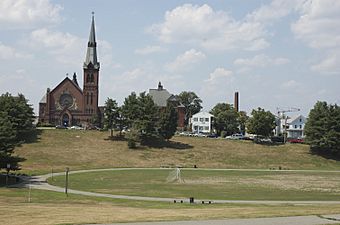South Common Historic District facts for kids
Quick facts for kids |
|
|
South Common Historic District
|
|

Buildings on Summer Street, viewed from the common
|
|
| Location | Lowell, Massachusetts |
|---|---|
| Architect | Multiple |
| Architectural style | Late Gothic Revival, Late Victorian |
| NRHP reference No. | 82001993 |
| Added to NRHP | August 10, 1982 |
The South Common Historic District in Lowell, Massachusetts, is a special area. It includes a large park called the South Common. This district also has many old and important buildings around the park. These buildings include homes, churches, and public offices. It's a place where history comes alive!
Contents
What is the South Common Historic District?
A historic district is a special area. It is recognized for its important history and old buildings. The South Common Historic District protects a large park and the buildings around it. These buildings show different styles from the past. The district helps keep these important places safe for the future.
How the South Common Began
The South Common is a big park, about 22.5 acres in size. The city of Lowell bought this land in 1845. It was purchased from a company called the Proprietors of Locks and Canals. This company owned much of the city's industrial land.
After the purchase, the common was made into a park. People started building fancy homes around it. Important public buildings also appeared. One example is the courthouse built in 1850. It was designed by Ammi Young. Several churches in the Gothic Revival style were also built. Highland Avenue became home to many beautiful Italianate style houses.
The Story of "Manice's Spite"
In the 1850s, a man named Patrick Manice owned land near the common. He did not want to sell his property to the city. So, the city built a wooden fence around his land. This fence enclosed him and his family!
Friends helped Mr. Manice by passing food through the fence slats. Finally, in 1856, he sold his house for $3500. This piece of land was then nicknamed "Manice's Spite." Later, in 1905, the city added fun things to the common. They built a running track, a baseball field, and a children's gym. This was part of a "city experiment" to offer more activities.
Important Buildings in the District
Many historic buildings are part of this district. They show the history and growth of Lowell. Here are some of them:
- 7 homes on Highland Street
- 7 properties on Summer Street, including the Eliot Church
- The Eliot School on Favor Street
- Hood's Laboratory on Thorndike Street, originally for making 'Hood's Sarsaparilla'
- The former Lowell Jail on Thorndike Street, which later became Keith Academy Catholic High School
- St. John's Church on Gorham Street
- St. Peter's Church and Rectory on Gorham Street
- The Middlesex County Courthouse on Gorham Street
National Recognition
The South Common Historic District was added to the National Register of Historic Places in 1982. This is a list of places in the United States that are important to history. Being on this list helps protect these special areas.



